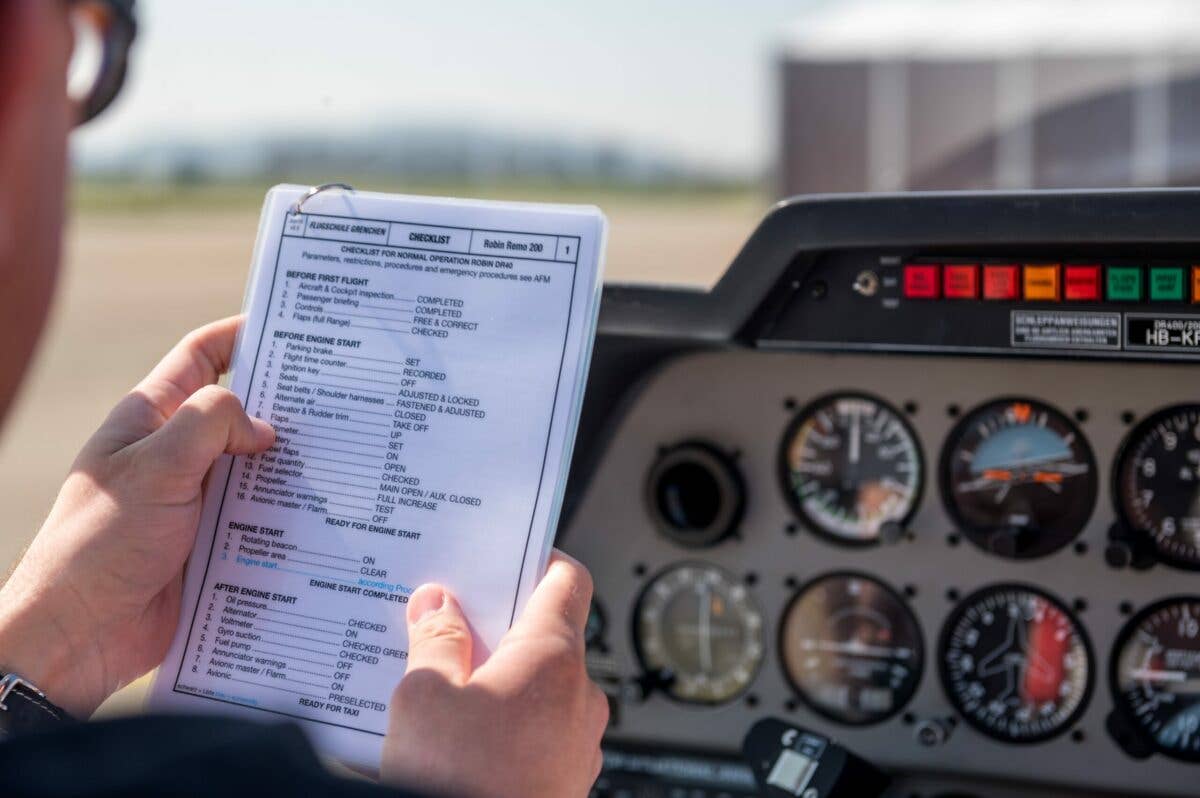Procedures for Stable Approaches
Verbalizing ‘pitch, power, trim’ is one of the main things to remember.

Flying “by the numbers” means staying ahead of the airplane, and in the pattern, this means more than using the checklist. [Shutterstock]
One of the first things you hear when you are learning to fly is that a poor approach will result in a poor landing. This is true. In a big way. Come in too fast and you will land far down the runway. Flare too high and there is a balloon-and-bounce scenario that no one wants.
Very often these events are the result of the pilot being behind the airplane or flying by rote—My instructor told me to land with full flaps, and I forgot, but here I am on short final, so I will dump them in, although the aircraft is low, according to the PAPI lights.
Every pilot goes through this learning curve. It can be addressed by focusing on the procedures for the pattern practiced away from the pattern, and at a high altitude, there is room to recover if a stall occurs.
Begin with the Checklist
Good checklist application should begin from the first lesson and the preflight inspection. The CFI can model this behavior. It is not uncommon for a new learner to ask why a checklist is used.
I watched one of my airport sons turned CFI working with a learner—his grandfather had helped train me—checklist in hand, and I was pleased to see son using it with his learner. When the learner asked why he “still had to use a checklist” if he had been flying for so many years, son tossed me a look as he said, "Because I have had good training."
Checklists for Maneuvers
There are checklists for preflight inspection, engine start, taxi, and run-up. Then, when it is time for takeoff, the checklist is often dropped, and on one occasion, tossed in the back seat by the learner who said he wouldn't need it for laps in the pattern or out in the practice area. Wrong.
In the practice area, the pre-maneuver checklist should be used because a rushed or poor setup—not unlike a poor pattern—will likely result in a poorly executed maneuver.
I witnessed this when working with a new-hire CFI. He was asked to demonstrate slow flight. After the clearing turns, he slowed the Cessna 172 into the white arc then dumped the flaps in all at once, resulting in a dramatic nose-up pitch, followed by a rough power-off stall and equally rough recovery from stall.
I pointed out the procedure checklist used by the school to teach slow flight indicated flaps should be added incrementally, and the learner’s attention called to the fact they were losing airspeed and needed to adjust trim and power to hold altitude and avoid a stall during slow flight. He replied, "My way saves time." "Your way doesn't teach slow flight," I countered, which was the lesson objective.
For reasons I have yet to fathom, he thought every time the learner performed the task they would have to read it off the maneuvers checklist, then perform the task. Read the next line, then perform a task. This was puzzling as at the top of each page on the checklist was the caveat, "Maneuvers should be memorized before check ride."
A bit of sleuthing revealed he had never been exposed to a maneuvers checklist before. This was of great concern to the airline pilot who was part owner of the school. He advised the CFIs that at the airlines, "You don't even scratch your nose without referring to a checklist."
- READ MORE: Make the Most of the Checklist
Study the Maneuvers Checklist
Before each flight, study the maneuvers checklist. Note the airspeed targets and aircraft configuration. Not only does it make your setup for maneuvers smoother, getting into this habit can help you stay ahead of the airplane in the traffic pattern, when things can get fast and furious.
Pattern Procedures
Most flight lessons that begin by heading out to the practice area terminate with a few laps in the pattern. Setting up for the pattern should begin before departing the practice area as the pilot in command (PIC) checks the weather and determines which runway is in use.
I am not a fan of diving down to pattern altitude while still in the practice area unless there is a darn good reason—like avoiding a shelf of airspace or hostile clouds—because 1,000 feet agl doesn't give you a lot of time to react should you have an uncommanded loss of engine power.
Instead, focus on a controlled descent—300 fpm, for example. I always ask my learners when we will be at pattern altitude—over what landmark? We stress being established at pattern altitude on the 45-degree leg to the pattern. As we enter this leg, the learner verbalizes the prelanding checklist, or GUMPS: gas, undercarriage, mixture, primer or pump, and safety items— seat belts and lights. Even if you are flying an aircraft with fixed gear, get into the habit of looking at the tire and verbalizing "gear down and locked."
Every time there is an aircraft configuration change, be it adjusting power or lowering flaps, the learners verbalize "pitch, power, trim" as they perform the action.
Airspeeds are called out. As most of them want careers as professional pilots, our students might as well get used to it. I started using the callout "white arc confirmed" after another CFI had a learner who dumped the flaps outside the white arc and damaged them.
It is critical to monitor the airspeed on downwind, as this is the longest leg in the pattern and gives you the most time to make adjustments. If you are in a twin or flying a high-performance single and sharing the pattern with slower aircraft, you will likely reduce power right after turning from crosswind to downwind so you do not crowd them. If you can't get your aircraft slowed down by the time you are abeam the numbers, depart the pattern and reenter on the 45.
You don't want to be chasing your own airplane as you roll on the base turn, adding extra flaps and jockeying the throttle, because when you go outside normal procedures, that is when mistakes happen.
The base-to-final turn has a lot of variables. You need to be at the correct altitude, airspeed, and aircraft configuration. Timing this turn is like throwing a pass to a wide receiver in football. You want to time it. Don't rush it and get uncoordinated—nor do you want to have such a shallow turn that you overshoot. I like to practice descending turns up at altitude, so in case we do have a stall, we can recover.
Rolling onto final, call your landing spot. Will you land on the numbers? The second centerline stripe?
Triple-check your landing gear: "Final clear, check the gear," as FLYING editor-in-chief/CFI Julie Boatman likes to say. Every. Single. Time. Retract or not.
Make sure the aircraft configuration, especially the airspeed, supports the choice of spot. If not, go around. Never try to “salvage” a poor approach or bounced landing unless it is an emergency.
When you touch down, please, please, please do not push the yoke forward or slam on the brakes.
Different Airplane, Different Procedures
Be very careful about negative transference—that is, doing the correct procedure for one airplane in the wrong airplane. We all do it at least once. It can happen subtly. You are used to flying a Cessna 182, which requires 20 degrees of flaps for a short-field takeoff, but that day you are flying a Cessna 172, which only requires 10 degrees of flaps.
If you are a CFI and fly several airplanes, you may find it handy to create a cheat sheet for each airplane that contains their numbers and procedural quirks. For example, one handles better with a power setting of 1,500 rpm, another 1,600, although they are both Cessna 172s. I wrote out personal notes for myself on 3-by-5 index cards and carried them in a pouch on a lanyard around my neck. I referred to them before each flight.
I told the learners this was like knowing which one of the kids I was babysitting was allergic to dairy, so I didn't accidentally poison them.
As the learner gets close to first solo, many instructors make it a rule that unless the approach is perfect, the learner will have to go around. Be careful with this as often the learner will try to force the airplane down on the third attempt, which, according to the FAA, is often when accidents take place.
Go around again and focus on the fourth attempt or have the CFI fly it with the learner talking them through the process and performing all radio calls. This gives the learner a chance to rest and really tests their knowledge as they are required to teach it back to the instructor.
There's a reason we do so many laps in the pattern during training. There's a lot going on. Practicing and following these procedures helps you stay ahead of the airplane. When you do the same thing pretty much every time—making slight corrections as warranted—you will have good approaches and landings.
In this way flying is a lot like cooking: Follow the recipe, and you'll get great results.

Subscribe to Our Newsletter
Get the latest FLYING stories delivered directly to your inbox






